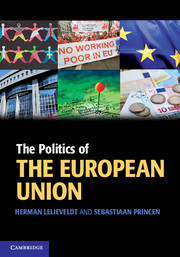Book contents
- Frontmatter
- Contents
- Acknowledgements
- List of briefings
- List of fact files
- List of controversies
- List of tables
- List of figures
- List of abbreviations and acronyms
- List of country abbreviations used in tables and figures
- Preface
- PART I Setting the scene: origins, analytical perspectives and institutions
- PART II Key actors in EU politics: citizens, interest groups and political parties
- Part III EU policies: agenda-setting, decision-making and implementation
- 8 An overview of EU policy-making
- 9 Agenda-setting
- 10 Decision-making
- 11 Implementing policies
- Conclusions and reflections
- Key terms and concepts
- Index
11 - Implementing policies
from Part III - EU policies: agenda-setting, decision-making and implementation
- Frontmatter
- Contents
- Acknowledgements
- List of briefings
- List of fact files
- List of controversies
- List of tables
- List of figures
- List of abbreviations and acronyms
- List of country abbreviations used in tables and figures
- Preface
- PART I Setting the scene: origins, analytical perspectives and institutions
- PART II Key actors in EU politics: citizens, interest groups and political parties
- Part III EU policies: agenda-setting, decision-making and implementation
- 8 An overview of EU policy-making
- 9 Agenda-setting
- 10 Decision-making
- 11 Implementing policies
- Conclusions and reflections
- Key terms and concepts
- Index
Summary
Introduction
In the spring of 2007 the Italian city of Naples experienced an acute breakdown of its rubbish collection system. Because waste landfills were full, rubbish collection became impossible and piles of trash quickly built up in the streets of Naples. Although the region of Campania had been struggling with its waste management system for years, the situation proved to be especially urgent this time. Residents started burning the rubbish in order to alleviate the smell of rotting material, transforming the city's streets into a grim scene with dark clouds of smoke and pedestrians covering their faces to avoid the smell. The crisis not only made headlines in the world news but also incited action on the part of the European Commission, which accused Italy of not living up to the terms of the Waste Framework Directive. A month later the Commission sent a formal warning to Italy because it had ‘failed to fulfil its obligations under the directive by not putting in place an appropriate network of disposal facilities ensuring a high level of protection for the environment and public health in the Campania region’.
Although the Italian government succeeded in addressing the most urgent problems – for example by sending its waste by train to waste incineration facilities in the German city of Hamburg – the Commission later that year still considered Italy to be in violation of the terms of the Directive.
- Type
- Chapter
- Information
- The Politics of the European Union , pp. 252 - 274Publisher: Cambridge University PressPrint publication year: 2011



